|
|
|
Sort Order |
|
|
|
Items / Page
|
|
|
|
|
|
|
| Srl | Item |
| 1 |
ID:
139820
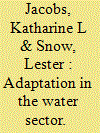

|
|
|
|
|
| Summary/Abstract |
Water management activities involve a complex and interconnected web of science, infrastructure considerations, societal expectations, and institutional limitations that has evolved over time. Much of the water management system's current complexity developed in response to the interests of local water users and land owners, historical water supply and demand issues, political demands, and water quality and environmental considerations. Climate change poses a new set of questions for water managers and may require more flexible solutions than those that have evolved historically. Although the implications of changes in the climate on water supply and demand are recognized (if not well quantified), ongoing changes in temperature and precipitation, as well as the linkages between environmental and societal factors, lead to major uncertainties in future conditions. New tools, techniques, and institutions will be needed to sustain water supplies for communities and watersheds in the future.
|
|
|
|
|
|
|
|
|
|
|
|
|
|
|
|
| 2 |
ID:
139822
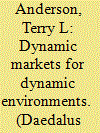

|
|
|
|
|
| Summary/Abstract |
Static models used in economics and ecology ignore dynamic processes at work in both human and natural systems. In the case of water management, whether for quantity or quality, static models fail to connect changing human demands on water systems with changing supplies due to short-run climate variations and long-run climate change. Water markets provide a way of connecting human demands to nature's supplies through prices, which signal values and scarcity. For water markets to make this connection, water rights must be well-defined, enforced, and tradeable. When they are, entrepreneurs are able to meet old and new demands on water ecosystems in novel ways, as examples in this essay illustrate.
|
|
|
|
|
|
|
|
|
|
|
|
|
|
|
|
| 3 |
ID:
139823


|
|
|
|
|
| Summary/Abstract |
Water is an essential building block of the Earth system and a nonsubstitutable resource upon which humankind must depend. But a growing body of evidence shows that freshwater faces a pandemic array of challenges. Today we can observe a globally significant but collectively unorganized approach to addressing them. Under modern water management schemes, impairment accumulates with increasing wealth but is then remedied by costly, after-the-fact technological investments. This strategy of treating symptoms rather than underlying causes is practiced widely across rich countries but leaves poor nations and many of the world's freshwater life-forms at risk. The seeds of this modern “impair-then-repair” mentality for water management were planted long ago, yet the wisdom of our “water traditions” may be ill-suited to an increasingly crowded planet. Focusing on rivers, which collectively satisfy the bulk of the world's freshwater needs, this essay explores the past, present, and possible future of human-water interactions. We conclude by presenting the impair-then-repair paradigm as a testable, global-scale hypothesis with the aim of stimulating not only systematic study of the impairment process but also the search for innovative solutions. Such an endeavor must unite and cobalance perspectives from the natural sciences and the humanities.
|
|
|
|
|
|
|
|
|
|
|
|
|
|
|
|
| 4 |
ID:
139818
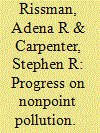

|
|
|
|
|
| Summary/Abstract |
Nonpoint source pollution is the runoff of pollutants (including soil and nutrients) from agricultural, urban, and other lands (as opposed to point source pollution, which comes directly from one outlet). Many efforts have been made to combat both types of pollution, so why are we making so little progress in improving water quality by reducing runoff of soil and nutrients into lakes and rivers? This essay examines the challenges inherent in: 1) producing science to predict and assess nonpoint management and policy effectiveness; and 2) using science for management and policy-making. Barriers to demonstrating causality include few experimental designs, different spatial scales for behaviors and measured outcomes, and lags between when policies are enacted and when their effects are seen. Primary obstacles to using science as evidence in nonpoint policy include disagreements about values and preferences, disputes over validity of assumptions, and institutional barriers to reconciling the supply and demand for science. We will illustrate some of these challenges and present possible solutions using examples from the Yahara Watershed in Wisconsin. Overcoming the barriers to nonpoint-pollution prevention may require policy-makers to gain a better understanding of existing scientific knowledge and act to protect public values in the face of remaining scientific uncertainty.
|
|
|
|
|
|
|
|
|
|
|
|
|
|
|
|
| 5 |
ID:
139821


|
|
|
|
|
| Summary/Abstract |
Cities in drought-prone regions of the American West and Australia provide examples of innovative approaches to utilizing local water resources to achieve more resilient water supplies. Geographical realities, population growth, and favorable economic conditions can create the impetus for investments in new technologies, while support by activist groups and NGOs can encourage more sustainable approaches using locally sourced water. New approaches–whether desalination, stormwater use, water recycling, or potable reuse–share a common path to mass adoption. After a period of piloting and demonstration-scale projects, water providers with few options become early adopters of new technologies. And after the early adopters have gained experience and have used it to support the new approaches, the costs and risks of failure decrease for other providers. Thus, a wider cross section can adopt the new approach. The pioneering projects described herein are the first stage of the reinvention of our urban water systems.
|
|
|
|
|
|
|
|
|
|
|
|
|
|
|
|
| 6 |
ID:
139816


|
|
|
|
|
| Summary/Abstract |
Water in its various forms–as salty ocean water, as sweet river water, or as rain–has played a major role in human myths, from the hypothetical, reconstructed stories of our ancestral “African Eve” to those recorded some five thousand years ago by the early civilizations to the myriad myths told by major and smaller religions today. With the advent of agriculture, the importance of access to water was incorporated into the preexisting myths of hunter-gatherers. This is evident in myths of the ancient riverine civilizations of Egypt, Mesopotamia, India, and China, as well as those of desert civilizations of the Pueblo or Arab populations.
|
|
|
|
|
|
|
|
|
|
|
|
|
|
|
|
| 7 |
ID:
139817
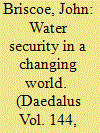

|
|
|
|
|
| Summary/Abstract |
This essay defines the concept of water security and explores the implications of the eternal pursuit of it. I will describe how water security is perceived by wealthy and by poorer nations, the tensions that arise from these differing views, and how these tensions are being resolved in a world in which the geography of economics and power is changing rapidly. I outline a few iconic cases of how societies have built institutions and infrastructure to deal with both floods and droughts. The essay assesses the effects of changes in climate and land use systems, and the differing reactions to the new perception of “nonstationarity”: the idea that these systems are less predictable than they have historically been. The essay concludes with some reflections on the challenges of educating young people seized with passion for the issues of their generation but who may have difficulty taking a long view of water security. Many have been taught about the environmental ravages wrought by water infrastructure, but few understand how these same infrastructure and institutions underpin the water security that the United States has achieved.1 Similarly, we teach the next generation too little about the remarkable contributions of “thinking practitioners”: experts who are also involved in policy-making and planning–whose work underpins the food, water, and energy security of their societies.
|
|
|
|
|
|
|
|
|
|
|
|
|
|
|
|
| 8 |
ID:
139819
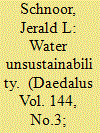

|
|
|
|
|
| Summary/Abstract |
Water is a vital renewable resource that is increasingly stressed by multiple and competing demands from people, industry, and agriculture. When water becomes unavailable or unusable, life itself cannot be sustained. Changes in supply and demand for water are driven by population growth, climate change, and our energy and land use choices. Poverty frequently precludes the ability of many people to respond and adapt to water insecurity. In this essay, we discuss the effects of these drivers on the diminution of rivers, aquifers, glaciers, and the severe pollution that renders some water resources unusable. While technologies for water reuse, desalination, aquifer replenishment, and better water pricing are important solutions, the recognition of water as a profoundly threatened resource and as a basic human right is essential for providing sustainable water for future generations.
|
|
|
|
|
|
|
|
|
|
|
|
|
|
|
|
| 9 |
ID:
139815


|
|
|
|
|
| Summary/Abstract |
Water issues are rarely simple. At the global scale, water is at the focus of a powerful multifaceted challenge. Demands for both consumptive and nonconsumptive uses are growing, while climate change is at the same time decreasing availability in some places and increasing risks of heavy precipitation in many others. Through diverse mechanisms that interact with natural processes, human activities impact not only the quantity of water available but also its quality. Here we explore the multiway interactions among water, climate, energy, and food through a number of case studies illustrating the interconnected web of competing drivers, demands, and trade-offs that frame humanity's decisions about water use. The net result of this complex mix of drivers and processes is that water issues need to be addressed with a systems perspective. While a systems framing can be daunting, integrated approaches are fundamental to identifying and evaluating options for sustainable solutions.
|
|
|
|
|
|
|
|
|
|
|
|
|
|
|
|
|
|
|
|
|